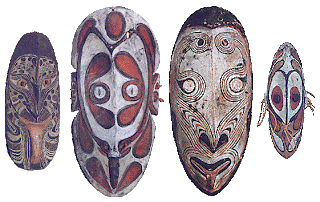
New Guinea was one of the first landmasses after Africa and Eurasia to be populated by modern humans , with first migration at approximately the same time as Australia.Agriculture was independently developed in the New Guinea highlands but more recently , some 300 years ago, the sweet potato entered New Guinea being introduced from South America by the locally dominant colonial power, Portugal.Its higher crops radically changed the traditional agricultural products.Although now almost entirely eradicated , in the past headhunting and cannibalism occurred in many parts of what is now Papua New Guinea.By the early 1950s through administration and mission presures, open cannibalism in Papua New Guinea had almost entirely ceased. The word "papua" comes from Malay and New Guinea from the resemblance of the inhabitants with that of Guinea coast of Africa.
The first European arrived in New Guinea were probably the Portuguese and Spanish navigators in the 16th century.With Europe's growing need for coconut oil Godeffroy's of Humburg, the largest trading firm in the Pacific , began trading for copra in the New Guinea Islands. In 1884 Germany formally took the possession of the north east quarter of the Island and put its administration in the hands of a Chartered Company. In 1899, the German imperial govt assumed direct control of the territory, Thereafter known as German New Guinea. In 1914, Australian troops occupied German New Guinea , and renamed under Australian military control. Until 1921, The British Government, on behalf of the commonwealth of Australia, assumed a mandate from the League of Nations for governing the territory of New Guinea in 1920. It was administered under this mandate until the Japanese invasion in Dec 1941 brought about the suspension of Australian civil administration. Following the surrender of the Japanese in 1945, civil administration of Papua as well as New Guinea was restored, and under the Papua New Guinea Provisional Administration act, 1945-46, Papua and New Guinea were combined in an administrative union.
The New Guinea campaign (1942-1945) was one of the major military campaigns of World War II. Approximately 216,000 Japanese , Australian and American soldiers, sailors, and airmen died during the New Guinea Campaign. The two territories were combined into the territory of Papua and New Guinea after WW II, which later was simply referred to as "Papua New Guinea.." The administration of Papua became open to United Nations oversight.
A secessionist revolt in 1975-76 on Bougaiville island resulted in an eleventh hour modification of the draft constitution of Papua New Guinea to allow for Bougainville and the other eighteen districts of pre-independence Papua New Guinea to have qusifederal status as provinces. The revolt recurred and claimed 20,000 lives from 1988 until it was resolved in 1997.Autonomous Bougainville elected Joseph Kabul as President but he was succeeded by John Tabinaman. He remained leader until the next election in2008 with Jsmes Tanis as winner.

